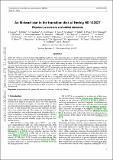An M-dwarf star in the transition disk of Herbig HD142527; Physical parameters and orbital elements
Abstract
HD 142527A is one of the most studied Herbig Ae/Be stars with a transitional disk, as it has the largest imaged gap in any protoplanetary disk: the gas is cleared from 30 to 90 AU. The HD 142527 system is also unique in that it has a stellar companion with a small mass compared to the mass of the primary star. This factor of ≈20 in mass ratio between the two objects makes this binary system different from any other YSO. The HD142527 system could therefore provides a valuable testbed for understanding the impact of a lower mass companion on disk structure. This low-mass stellar object may be responsible for both the gap and the dust trapping observed by ALMA at longer distances. We have observed this system with the NACO and GPI instruments using the aperture masking technique. Aperture masking is ideal for providing high dynamic range even at very small angular separations. We present here the SEDS for HD 142527A and B from the R band up to the M band as well as the orbital motion of HD 142527B over a period of more than 2 years. The SED is compatible with a T = 3000 ± 100 K object in addition to a 1700\,K black body environment (likely a circum-secondary disk). From evolution models, we find that HD142527B is compatible with an object of mass 0.13 ± 0.03 Msun, radius 0.90 ± 0.15 Rsun and age 1.0+1.0−0.75Myr. This age is significantly younger than the age previously estimated for HD142527A. Computations to constrain the orbital parameters found a semi-major axis of 140+120−70\,mas, an eccentricity of 0.5 ± 0.2, an inclination of 125 ± 15 degrees, and a position angle of the right ascending node of −5 ± 40 degrees. Despite its high eccentricity, it is unlikely that HD142527B is responsible for truncating the inner edge of the outer disk.
Citation
Lacour , S , Biller , B , Cheetham , A , Greenbaum , A , Pearce , T , Marino , S , Tuthill , P , Pueyo , L , Mamajek , E E , Girard , J H , Sivaramakrishnan , A , Bonnefoy , M , Baraffe , I , Chauvin , G , Olofsson , J , Juhasz , A , Benisty , M , Pott , J-U , Sicilia-Aguilar , A , Henning , T , Cardwell , A , Goodsell , S , Graham , J R , Hibon , P , Ingraham , P , Konopacky , Q , Macintosh , B , Oppenheimer , R , Perrin , M , Rantakyrö , F , Sadakuni , N & Thomas , S 2016 , ' An M-dwarf star in the transition disk of Herbig HD142527; Physical parameters and orbital elements ' , Astronomy & Astrophysics , vol. 590 , A90 . https://doi.org/10.1051/0004-6361/201527863
Publication
Astronomy & Astrophysics
Status
Peer reviewed
ISSN
0004-6361Type
Journal article
Description
S.L. acknowledges fruitful discussions with S. Casassus about the existence of HD 142527B and the inner disk of HD 142527A. This research made use of Astropy, a community-developed core Python package for Astronomy (Astropy Collaboration et al. 2013). This work was supported by the French National Agency for Research (ANR-13-JS05-0005) and the European Research Council (ERC-STG-639248). A.G. and A.S. acknowledge support from NSF Graduate Research Fellowship grant No. DGE-1232825 and NASA grant NNX11AF74G. J.O. acknowledges support from the Millennium Nucleus RC130007 (Chilean Ministry of Economy). I.B. acknowledges the European Research Council through grant ERC-AdG No. 320478-TOFU. Based on observations collected at the European Southern Observatory (ESO) during runs 088.C-0691(A), 090.C-0649(A), 091.C-0572(A), and 094.C-0608(A). Also based on observations obtained at the Gemini Observatory (programs GS-2014A-SV-406 and GS-ENG-GPI-COM), which is operated by the Association of Universities for Research in Astronomy, Inc., under a cooperative agreement with the NSF on behalf of the Gemini partnership: the National Science Foundation (United States), the National Research Council (Canada), CONICYT (Chile), the Australian Research Council (Australia), Ministério da Ciência, Tecnologia e Inovação (Brazil) and Ministerio de Ciencia, Tecnología e Innovación Productiva (Argentina).Collections
Items in the St Andrews Research Repository are protected by copyright, with all rights reserved, unless otherwise indicated.

